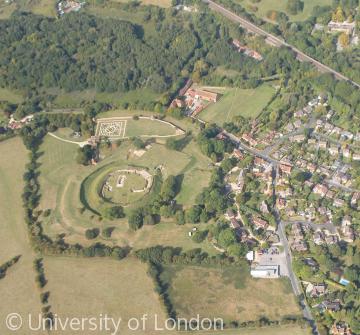The English Civil War
 Aerial view of the ruins of Basing House, a fortified house in Old Basing, Hampshire destroyed in 1645 and not rebuilt.
Aerial view of the ruins of Basing House, a fortified house in Old Basing, Hampshire destroyed in 1645 and not rebuilt.Civil War broke out in England in August 1642 between Charles I and his Parliament. The causes were political, religious and financial. Charles I believed in the divine right of kings. In Europe absolute monarchy increased in the 17th century but England had a parliament with the right to grant taxation to the monarch. In the early seventeenth century some MPs, led by puritan John Pym, sought increased power for Parliament. The divisions intensified because of religious differences. England had rejected Catholicism at the Reformation but the Anglican Church retained many catholic practices such as bishops and altars in the east end of churches, separated from the congregation by an altar rail or screen. Arminians in the Church of England including Charles I and, from 1633, his archbishop of Canterbury, William Laud, supported high church rituals. They were opposed by Puritans who wanted further doctrinal reformation in England and simpler churches, plain clothes, respect for the Sabbath. Charles I dismissed Parliament and ruled personally from 1629-40, using devices such as Ship Money to raise revenue.
Charles sought to impose his High Church Anglicanism on Catholic Ireland and Presbyterian Scotland leading to conflict. Rebellion broke out in Scotland in 1639. Charles had to recall the English Parliament and seek cash to raise an army which was only granted after Charles made religious, political and financial concessions and sacrificed his minister, the earl of Strafford, and William Laud. The Scots meantime had invaded Northumberland and Durham. Rebellion broke out in Ulster late in 1641 when Catholics massacred Protestants at Portadown. Charles was suspected of having Catholic sympathies. Relations with parliament deteriorated.
The King raised his standard at Nottingham on 22nd August 1642. He held the north and west of England from his base at Oxford University while Parliament held the south and east including London. The earl of Essex was lord general for parliament while the earl of Manchester commanded the Eastern Association army, in which Oliver Cromwell served. Lord Fernando Fairfax and his son, Thomas, led parliamentarian forces in northern England. Fighting in 1642-1643 from Hampshire to Cornwall and in the north was indecisive with many inconclusive battles such as Edgehill, Newbury, Alton, and sieges at for example Bristol, Lyme, Basing House, Gloucester, but the entry of the Scots, negotiated by John Pym shortly before his death, into the English civil war in 1644 was a turning point. David Leslie and his 20,000 Scots army assisted Sir Thomas Fairfax and Oliver Cromwell to defeat the royalists, led by the duke of Newcastle and Prince Rupert, at Marston Moor near York in July 1644. The north of England fell to Parliament but the earl of Essex was humiliated in Cornwall. Parliament secured victory in 1645 at Naseby following the creation of the New Model Army with Sir Thomas Fairfax replacing the earl of Essex as Lord General and Oliver Cromwell in charge of cavalry. It was disciplined, united under one leader and better supplied than previous armies and passionate about defending English liberties. The war dragged into 1646 when Charles fled to the Scots who handed him over to parliament in return for cash. Bishops were abolished in 1646. Churchwardens’ accounts reveal which parishes converted to Presbyterianism and purchased its Directory to replace the prayer book.
Parliament proposed political reforms to the king from 1646-8 but Charles was inflexible and would not compromise. While in prison on the Isle of Wight, Charles master minded the second civil war in 1648 which led the politicized officers of the new Model Army to condemn him as a ‘man of blood’. Moderate parliamentarians were excluded by the army in December 1648 and the King was put on trial and finally executed outside the Banqueting Hall, Whitehall on 30 January 1649.
Radicalism flourished in the turbulent times and censorship collapsed. The Levellers campaigned for one man one vote threatening the power of the propertied classes. Organized religion whether Church of England or Presbyterian was threatened by dissenters such as Baptists, Fifth-monarchists, Quakers, Ranters and Seekers. Baptism was particularly strong in the New Model Army. Following Charles’ execution monarchy, the House of Lords and cathedrals were abolished. Many castles such as Basing House, Hampshire, destroyed during the fighting, were not rebuilt. After the Restoration some were replaced by stately homes such as Belvoir Castle.
The English Republic lasted until May 1660. From 1649-53 the Rump Parliament, MPs surviving from the Parliament elected November 1640, governed. Oliver Cromwell and the New Model Army conquered Ireland and Scotland in the name of this Parliament. The Scots invaded England in the brief third civil war designed to restore Charles II to the throne but he was defeated at Worcester in September 1651 and eventually fled to France. Parliament was dismissed by Oliver Cromwell in April 1653 for failing to create godly government and replaced with a Nominated Assembly of men chosen for their Godliness. This collapsed within months and Oliver Cromwell became Lord Protector. Cromwell experimented with military government in 1656, appointing eleven major generals to run England. Cromwell died in September 1658 and was succeeded by his eldest son, Richard, who lacked the skill to govern. Chaos resulted leading to the Restoration of Charles II in May 1660.








